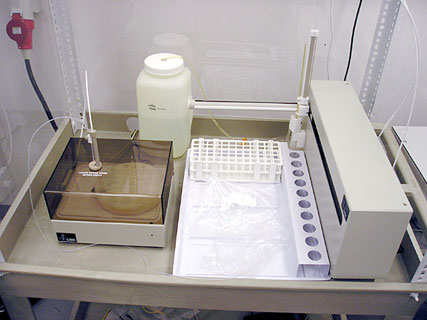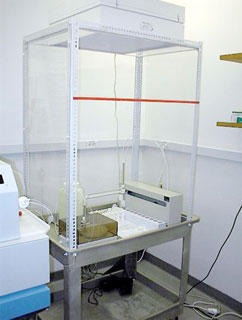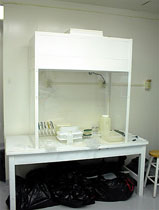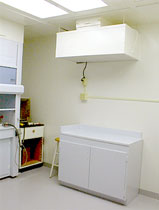Analytical Laboratory
For more information about the Analytical Laboratory Capabilities and charges, or to schedule analyses, please contact Roy Price at roy.price@stonybrook.edu, or Caitlin Asato at caitlin.asato@stonybrook.edu. The SoMAS Analytical Facility provides reliably standardized analytical measurements of frequently required environmental parameters (Nitrogen, Carbon, Phosphorous, Sulphur and Silica Species and Trace Elements) mostly in support of Student and Faculty research. We accept samples from outside Stony Brook on a time available basis. We specialize in measurements at low concentration levels in environmental samples (sediments, soils, fresh and seawater samples, and organisms). Each instrument has a well developed database of blank, precision, and long term accuracy information from external and internal reference material results in a variety of matrices. Estimates of detection limit, accuracy, and precision for various analyte/matrix combinations are available on request. Members of the Stony Brook University community who want to gain experience in the use of these instruments are welcome to receive instruction in their operation. We also provide advice about field sample preservation techniques for these analytes and suggest consultation about this before sampling. As an Academic Lab we take the time to help our users obtain accurate measurements in a wide variety of unusual samples. The SOMAS analytical facility is certified in accordance with and pursuant to section 502 Public Health Law of New York State as an approved Environmental Laboratory in conformance with the National Environmental Laboratory Accreditation Conference Standards (2003) for the category Environmental Analyses Non Potable Water (N.Y. Lab Id No:12075) for the following approved analytes and these analytes only:
- Ammonia (as N)
- Lachat 10-107-6-1B,J Nitrate (as N)
- Lachat 10-107-4-1C Nitrate-Nitrite (as N)
- Lachat 10-107-4-1C Nitrite (as N)
- Lachat 10-107-4-1C Orthophosphate (as P)
- Lachat 10-115-01-1-A,B
CNS Elemental Analyzer (Thermo EA1112): Solid phase analyses of Carbon, Nitrogen, and Sulphur. (sediment, soil, organisms, filters
A high mass resolution Inductively Coupled Plasma (magnetic sector) Mass Spectrometer (ICPMS), with several class-100 trace metal clean benches and sample introduction systems. For the analysis of a wide variety of inorganic (Trace Metals) elements at low levels (PPB to sub PPB) in acid dissolved environmental samples. The capabilities of this instrument are especially sensitive to analyte matrix effects. Please inquire for information about using this instrument.
The SoMAS Analytical Facility provides reliably standardized analytical measurements of frequently required environmental parameters (Nitrogen, Carbon, Phosphorous, Sulphur and Silica Species and Trace Elements) mostly in support of Student and Faculty research. We accept samples from outside Stony Brook on a time available basis. We specialize in measurements at low concentration levels in environmental samples (sediments, soils, fresh and seawater samples, and organisms). Each instrument has a well developed database of blank, precision, and long term accuracy information from external and internal reference material results in a variety of matrices. Estimates of detection limit, accuracy, and precision for various analyte/matrix combinations are available on request. Members of the Stony Brook University community who want to gain experience in the use of these instruments are welcome to receive instruction in their operation. We also provide advice about field sample preservation techniques for these analytes and suggest consultation about this before sampling. As an Academic Lab we take the time to help our users obtain accurate measurements in a wide variety of unusual samples.
The Analytical Facility consists of the following Instrumentation:
CNS Elemental Analyzer (Thermo EA1112): Solid phase analyses of Carbon, Nitrogen, and Sulphur. (sediment, soil, organisms, filters)
Automated Flow Injection Colorimeter (Quickchem FIA-8000 Autoanalyzer): Modules for high (Coastal Seawater, Groundwater, Wastewater) and low (Oligotrophic Seawater) dissolved Nitrate, Nitrite, Ammonia, Phosphate, Silicate, Chloride, and Sulphate.
Dissolved Organic Carbon and Total Nitrogen Analyzer (Shimadzu TOC-L/TNM-L): Seawater and Freshwater measurements of dissolved Organic and Total Carbon and dissolved Total Nitrogen.
Inductively Coupled Plasma Mass Spectrometer (Thermo-Finnegan Element2)
https://you.stonybrook.edu/somas/files/2015/02/tel_01-13hc2e9.jpg
A high mass resolution Inductively Coupled Plasma (magnetic sector) Mass Spectrometer (ICPMS), with several class-100 trace metal clean benches and sample introduction systems. For the analysis of a wide variety of inorganic (Trace Metals) elements at low levels (PPB to sub PPB) in acid dissolved environmental samples. The capabilities of this instrument are especially sensitive to analyte matrix effects. Please inquire for information about using this instrument.
Graphite Furnace/Flame Atomic Absorption Spectrometer (Perkin Elmer AAnalyst 800): Analysis of a wide variety of elements at the PPM to Sub PPM level in environmental samples.
https://you.stonybrook.edu/somas/files/2015/02/tel_10-291n1tw.jpg
CETAC ASX-100 micro-autosampler and CETAC ASX-510 auto-sampler
The ASX-100 random access intelligent micro autosampler is designed for use with sample volumes from 200 microliters to 1500 microliters. It is the ideal auto sampler to use with any application that requires analysis of small volume samples. The ASX-100 was specifically designed for ultra-trace level analysis. The ASX-510 random access intelligent autosampler is used with high volume samples (milliliters). A continuous flow sample probe rinse station incorporating a built-in peristaltic pump is used to reduce contamination and sample carryover. Both autosamplers at the MSRC Trace Element Laboratory are located inside a class-100 trace metal clean bench to minimize sample contamination.
CETAC U-6000AT+ Nebulizer and AridusTM Desolvating Microconcentric Nebulizer
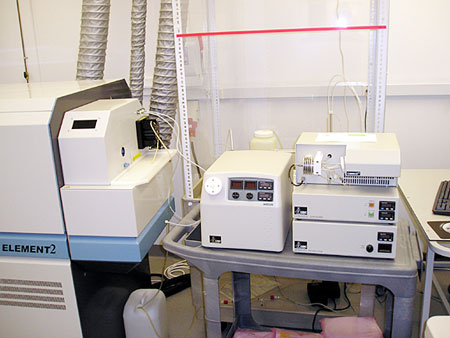 The Aridus sample introduction system is a third generation sampling device that provides the advantages of desolvation and micro-volume sampling. The U-6000AT+ adds a second desolvation stage (membrane desolvator) to the U-5000AT+ nebulizer. The membrane desolvator effectively removes solvent (water and volatile organics) which escapes from the U-5000AT+condensor. The use of these two systems provides up to two order of magnitude enhancement in sensitivity, improves detection limits and reduces many polyatomic ion interferences.
The Aridus sample introduction system is a third generation sampling device that provides the advantages of desolvation and micro-volume sampling. The U-6000AT+ adds a second desolvation stage (membrane desolvator) to the U-5000AT+ nebulizer. The membrane desolvator effectively removes solvent (water and volatile organics) which escapes from the U-5000AT+condensor. The use of these two systems provides up to two order of magnitude enhancement in sensitivity, improves detection limits and reduces many polyatomic ion interferences.
For further information about the ICPMS-Nebulizer coupling, please consult:
Field, M.P., and Sherrell, R.M. 2003. Direct determination of ultra-trace levels of metals in fresh water using desolvating micronebulization and HR-ICP-MS: application to Lake Superior waters. Journal of Analytical Atomic Spectrometry 18, 254-259.
Field, M.P., Cullen, J.T. and Sherrell, R.M. 1999. Direct determination of 10 trace metals in 50 μL samples of coastal seawater using desolvating micronebulization sector field ICP-MS. Journal of Analytical Atomic Spectrometry 14, 1425-1431.
Class-100 Trace Metal Clean Laboratory
For sample preparations and manipulations
Graphite Furnace/Flame PerkinElmer AAnalyst 800 Atomic Absorption Spectrometer
For single metal analysis, the Trace Element Laboratory is equipped with an AAnalyst 800. This instrument is equipped with an automated motorized atomizer, allowing switching between flame and furnace by software command. The instrument is equipped with a transversely heated graphite atomizer (THGA) with longitudinal Zeeman effect background corrector. The graphite furnace system includes true temperature control and integrated platform tubes providing STPF conditions for almost interference-free trace metal analysis.
Shimadzu High Performance Liquid Chromatographer
For analysis of dissolved organic constituents, the Trace Element Laboratory is equipped with a Shimadzu HPLC (LC-VP/LC-10A series) with UV-Vis and fluorescence detectors. This instrument is being interfaced with the ICP-MS for the determination of different organic species of trace metals in natural waters.








